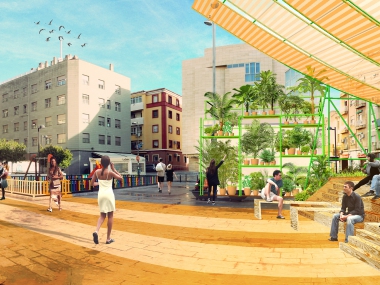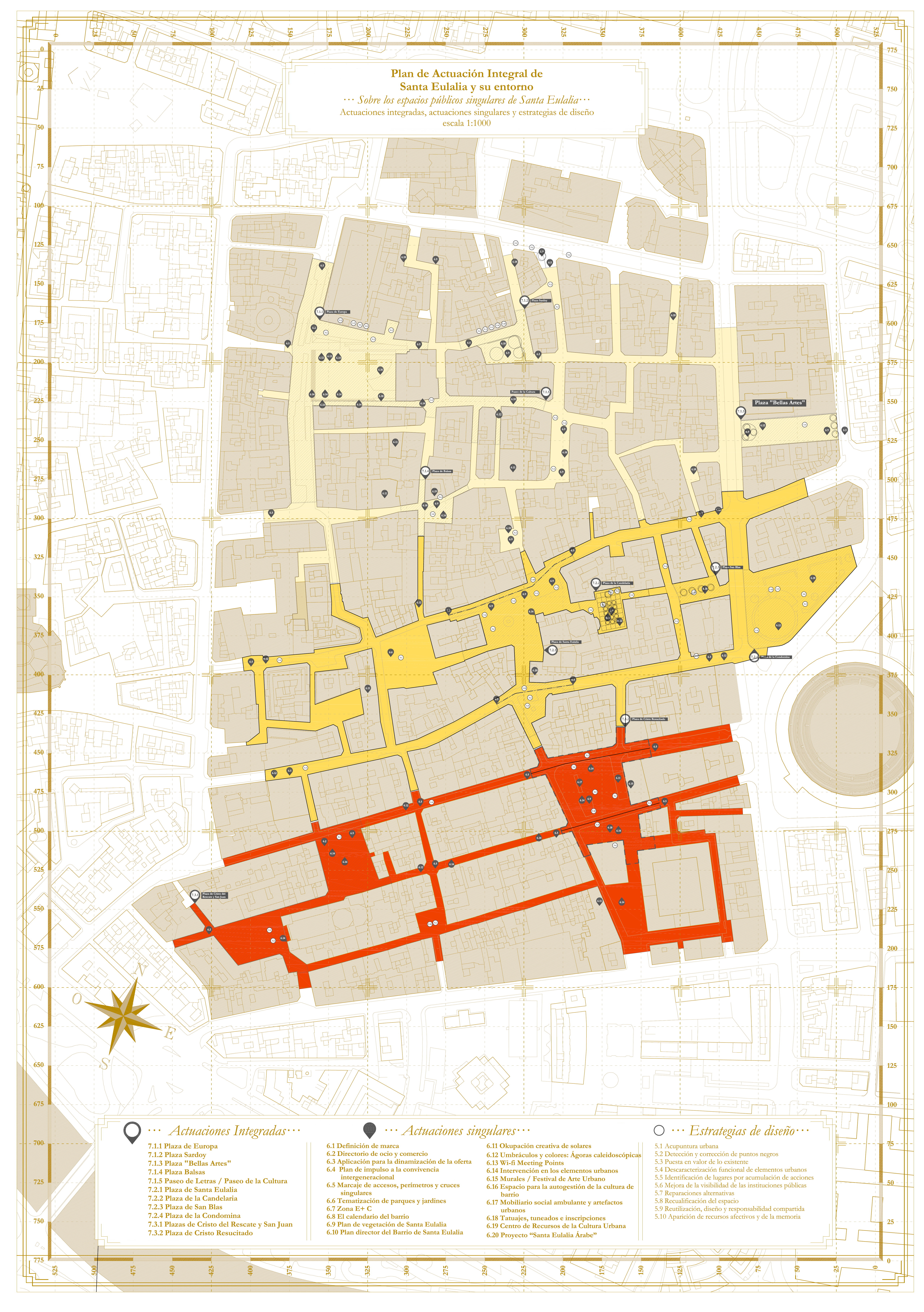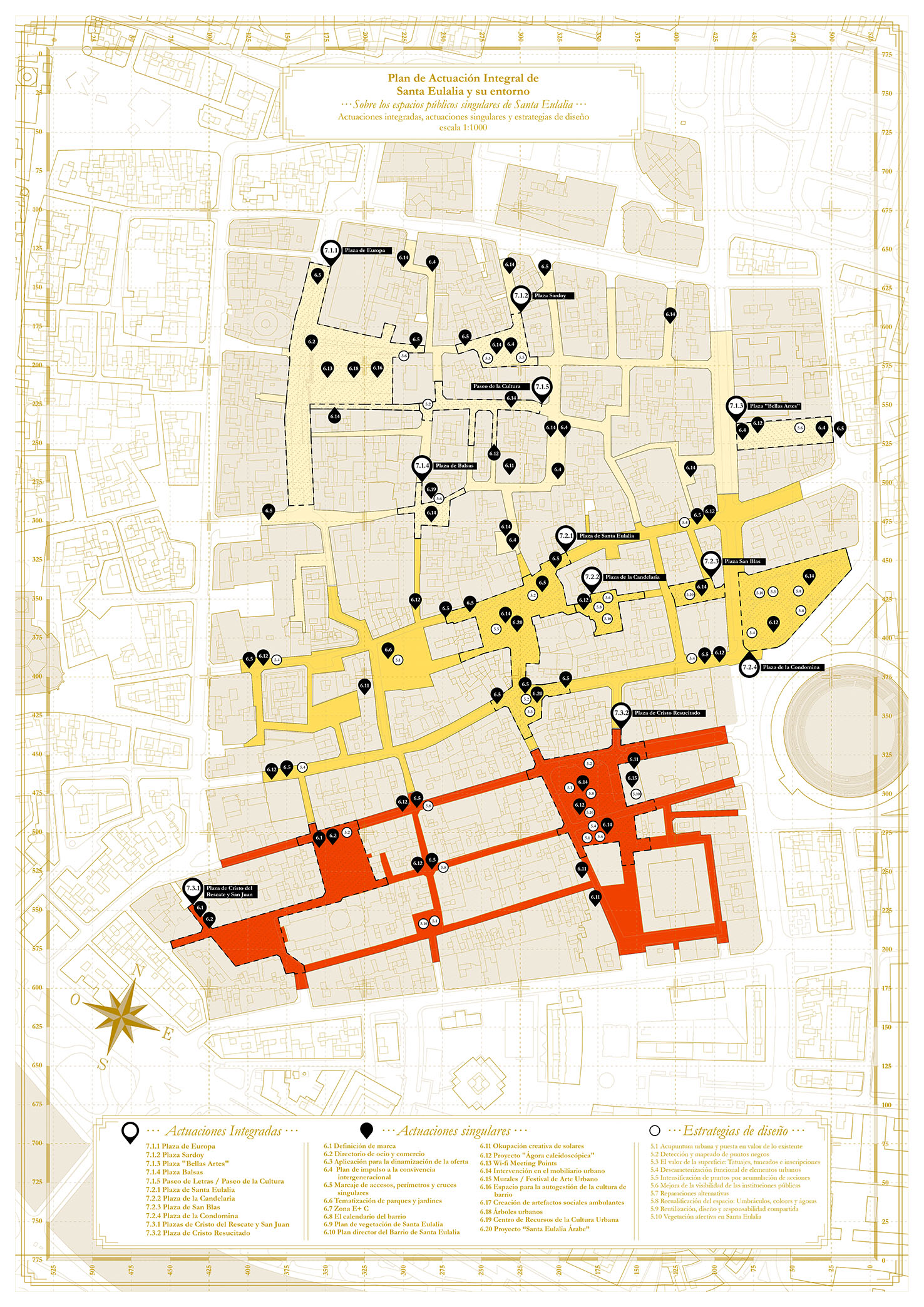Urban acupuncture: Murcia City Labs Santa Eulalia
Edited on
02 October 2018The Santa Eulalia Intervention and Citizen Participation Process focuses on a unique model contrary to the urban planning model set out by the experts. The area where the intervention will take place is the Santa Eulalia neighbourhood and its surroundings in Murcia, a city located in the southeast of Spain. It has an area of 170,000 m2 characterized by close-knit, narrow streets of medieval origin, which add a certain character, in spite of a lack of relevant historical buildings. Considered compact and homogeneous, the neighbourhood has little marginalisation, poverty or physical deterioration.

The willingness of the municipal corporation to intervene in Santa Eulalia has led to the implementation of a intervention model that takes into account both the accumulated knowledge from similar projects, originating from very different contexts, and from projects reacting to local phenomena such as the bursting of the Spanish housing bubble in 2007, the subsequent and still ongoing economic and institutional crisis and demands for new forms of responsibility linked to climate change.
The growth and evolution of the urban fabric of the city of Murcia since the arrival of democracy in 1975 is another example of the methods of urbanization that have developed in Europe throughout the second half of the twentieth century. It is a simplistic planning model concerned with adapting existing urban environments to industrial production methods: in this aspect, the city would effectively be “just another one of its products”. These methods of city-building were fuelled by the model of functional specialization, in which the zoning that Le Corbusier pushed to its limits with his “Charter of Athens” (La Carta de Atenas, 1942) played a decisive role. In fact, some of those planning patterns still account for a large portion of today's urban planning.
In this way, nowadays we find that intervention tools are highly standardised, for example monofunctional zoning, formal hierarchy and clarity, confidence in expert city planners, centralisation of decision-making, etc. Tools like these are geared towards the rigorous manufacturing of a final image of the city in which the shape of the different parts can be explained by their functional relationship with the other parts. From this point of view, the city could be considered one of the leading products of human thought, which would exemplify the potential of using logical reasoning to control and govern cities with high levels of heterogeneity or diversity by organising their most basic elements.
 |
It should be noted that placing total confidence in the hands of experts in both centralised planning and management relies on the pragmatic interpretation of human constructions, the anomalies of which are seen as harmful and are eliminated through intensified regulation and the avoidance of analysis and study programs based on citizen participation. However, for some recent authors, anything that resembles an understanding of the city passes as a change in era that would have placed us in a third age of modernity characterised by a variety of phenomena such as greater reflexivity, new types of social relations, the effect of networks, a knowledge economy, or the role of information technologies (Ascher 2009, Bauman 2002, Castell and Borja 1998).
These profound changes would render a unified city project unviable, if the aim was to study the city not as an unfinished and imperfect product but as something in its testing phase, where a large quantity of external information has a radically influential effect, it can create unstable urban characteristics which can neither be controlled nor normalized by public institutions nor by private forces. These kinds of difficulties are especially visible when it comes to imagining the future of a neighbourhood like Santa Eulalia and its surroundings, set in a city in the southeast of Spain but largely forgotten by tourists in search of beaches and sun. It has therefore had to visualise its future from a more complex perspective which breaks away from the traditional models of city planning.
 |
In addition to the theoretical developments which perceives some of the limitations of centralized planning as problematic, several examples can be considered which break with the inherent linearity of this type of tool stemming from the study of some of the problems associated with them such as their difficulty in addressing inequality or social exclusion, their openness to corruption, the difficulty faced when dealing with either the individuality or the loss of identity of urban fabrics on which they operate. These are examples of resistance to the dominant models that are characterized by their affirmative and voluntary experimental condition. Despite sharing a common trunk, the different branches of this intentional opposition to the field of classic urban planning have adopted specific characteristics and specific definitions such as emergent urbanism, informal urbanism, bottom-up urbanism, tactical urbanism, etc.
We are aware that the urban identity or the emotional recognition by the communities of their local places can be vital for the sustainability of the whole neighbourhood. We also know that neighbourhoods these days are driven to specialise and compete with each other to be more attractive to tourists and income. While this competition usually involves the renovation of degraded historical quarters of the cities, the revitalisation of obsolete industrial sites or the promotion of culturally important areas often also lead to the establishment and standardization of cities, with the consequential loss of identity and a decline in the overall quality of life for its inhabitants. In recent years, important questions have also arisen about new forms of governance which raise doubts about the types of justice inherent in certain ways of centralised city-building. These considerations include proposing alternatives that consider the aspects of urban life most open to external participation and to future participants. In this context then, what opportunities do Santa Eulalia and, by extension, the city of Murcia have? What is it that makes it unique? In this paper, we will study some of the controversy surrounding these questions, based on Santa Eulalia as a cross-linking of experiences which, through its ongoing experimental status, defies and examines the unchanging systems of city approaches.
 |
Sentiments and Ecologies
Of the many problematic issues that stem from the models that simplify thoughts and actions towards the city, there are two that have been the focus of the development of the design strategies applied to Santa Eulalia. These are based on some of the area’s unique aspects. The first aspect proposes the revision of the role played by our emotions in the creation of a city. It is true that these are often featured when cities with an extended past are analysed. However, modernism failed to take them into account when envisioning the future. Sentiments do not seem to be one of the relevant issues from an efficient and competitive point of view, and are not usually considered in the centralised planning of a city. However, numerous studies prove the importance of these "too human" issues when it comes to improving our capabilities and quality of life. How could their creative aspect also be considered?
Until very recently, only psychoanalytical studies were concerned with analysing the dimension of human feelings. However, more recently, authors such as Eva Illouz or Eloy Fernández Porta have addressed these issues from the viewpoint of contemporary patterns like interpersonal relationships or patterns of mass-consumption (Illouz 2007, 2014, Fernández Porta 2010, 2012).
This attention to citizens’ emotions has been channelled through the classical dynamics of participation in the Santa Eulalia Project, and has enabled them to be used to generate expectations and the subsequent structure of opinion and interest. The recognition of the history of the neighbourhood, for example, does not translate directly into urban interventions, but has served to cross-link knowledge, generate unsuspected alliances and enrol agents who otherwise would not have appeared to participate in the process. Furthermore, along with the role of emotions, seduction and desire appear as the "translations" of emotions into the operational field. Seduction does not enter into large structural approaches but it easily relates to empathy, through which it manifests capacities such as imagination and creativity towards consensus-based decision-making, shared perception and overlapping localised ways of life in the neighbourhood.
The second issue affects the differential role that sustainability can play in a consolidated neighbourhood such as Santa Eulalia. It can be said that environmental concerns have been expressed in the field of architecture based on patterns of guilt and the need for atonement. Since the material production of the city is responsible for a large part of greenhouse gas emissions, architecture seems to have reduced the burden of solving exclusively these kinds of issues. The problem, as has been stated from many points of view, is that the rates of improvement in the reduction of consumption are too slow to rely exclusively on technical solutions (Morton, 2010). For example, the most reasonable alternatives aim to improve the city's performance as a laboratory capable of improving the performance of the communities that inhabit it, but also of the city itself as a pedagogical artefact (MacFarlane, 2010).
From this point of view, the interventions envisioned in Santa Eulalia will seek to convert the "construct" of the city into a laboratory in which to test more sustainable practices for the strengthening of community ties and the recognition of citizens. It is a question of understanding that environmental problems do not have a single source that can be addressed by technology, but rather that they are the collateral effects of the excesses of capitalism and therefore must be addressed structurally. These issues surrounding the possibility of an ecology of practices (Stengers, 2005) are neither closed nor clearly described, but rather have been proposed as ongoing experiments, the success of which will require their documentation and the subsequent management of the obtained information. Only in this way will this set of experiences be effective through their links and oppositions to other similar experiences. In this way, we would be moving toward an ecological consideration of the neighbourhood, more attentive to the quality of the interactions that occur and less concerned about technological issues of questionable veracity.
Urban Acupuncture
Santa Eulalia is a dense and consolidated neighbourhood. It is already “established” and it is the setting of many stories, looks and conflicts that the residents recognise at every stage. The proposed interventions do not aim to alter their general state, but to slightly modify the balances and material deals on which their daily lives are based. These are widespread, gentle interventions that slightly modify the life of the neighbourhood, implementing improvements and correcting small "mistakes" accumulated over time.
In order to successfully undertake a broad set of heterogeneous actions without the result being perceived in a fragmented way, it has been necessary to define a set of common intervention strategies. These set desirable parameters, guide decision making, facilitate the participation of different agents, improve communication and subsequently allow effective management of the process. The strategies used, which are optimal for application in consolidated urban contexts, have generally been tested elsewhere with successful results. As a whole, these intervention strategies are part of what is commonly known as urban acupuncture, in the sense described by authors like Jaime Lerner from his work in Curitiba (Lerner, 2003).
This expression makes explicit reference to the painless and non-invasive therapeutic properties of traditional Chinese medicine to make a sustainable approach to urban practices viable. From this point of view, urban acupuncture refers to the possibility of solving major problems based on gentle actions that correct errors and produce very localised improvement. In addition, it proposes the creation of a hierarchy of points and places of great impact in the life of the districts, which would have to be treated and improved with special intensity.
The success of this set of methodologies depends on the knowledge of the related contexts and the search for very detailed solutions. This is very sensitive and uncertain knowledge, which eschews general theories. In order to encourage its appearance and make it possible to record it, it is essential to have participation of citizens and users, with the assurance that their non-expert knowledge is useful and beneficial. Valuing experiential knowledge helps the empowerment of citizens and encourages them to identify with the context in which they live. In fact, through these processes, it is the body itself that relates to the urban space, which promotes self-knowledge and the public projection of subjective creativity, which often finds no useful forms of expression.
Casagrande appeals to the post-industrial condition of the city that expresses itself through participation, and calls it a “Third Generation City” characterised by self-producing mechanisms based on cooperation and mutual knowledge. This is very distant from the rigorous, speculative and competitive forces of the industrial city. For the success of urban acupuncture, a shared diagnosis is essential through the joint participation of all the social agents involved, the activation of desire by public institutions, the continuity of the strategy over time and its resilience to changes and opportunities that arise.
In the case of Santa Eulalia these demands have been worked extensively, in that the morphological characteristics of the neighbourhood have fostered, over time, a feeling of belonging among the inhabitants and the development of unique lifestyles. In a future article, we will reflect on the different design strategies that have emerged from this holistic consideration of our neighbourhood.
Enrique Nieto Fernández
Universidad de Alicante
enrique.nieto@ua.es
Bibliography
ASCHER, F., 2012. Los nuevos principios del urbanismo: el fin de las ciudades no está a la orden del día. Madrid: Alianza Editorial.
BAUMAN, Z., 2002. Modernidad líquida. Buenos Aires ;;Bogotá: Fondo de Cultura Económica de Argentina.
CASTELLS, M. y BORJA, J., 1996. Local y global: la gestión de las ciudades en la era de la información. España: Naciones Unidas.
FERNÁNDEZ PORTA, E., 2010. €®O$ [Eros]: la superproducción de los afectos. Barcelona: Editorial Anagrama.
FERNÁNDEZ PORTA, E., 2012. Emociónese así: anatomía de la alegría (con publicidad encubierta). Barcelona: Anagrama.
ILLOUZ, E., 2007. Intimidades congeladas: las emociones en el capitalismo. Buenos Aires; Madrid: Katz.
ILLOUZ, E., 2014. El futuro del alma ; La creación de estándares emocionales. S.l.: s.n.
LERNER, J., 2003. Acupuntura urbana. Barcelona: IAAC.
MCFARLANE, C., 2010. Learning the city: knowledge and translocal assemblage. Oxford: Wiley-Blackwell. ISBN 978-1-4051-9282-8.
MORTON, T., 2010. The ecological thought. Cambridge, Mass.: Harvard University Press. ISBN 978-0-674-04920-8. STENGERS, I., 2005. Introductory notes on an ecology of practices. Cultural Studies Review, vol. 11, no. 1, pp. 183-196.
Submitted by fvirgilio on
